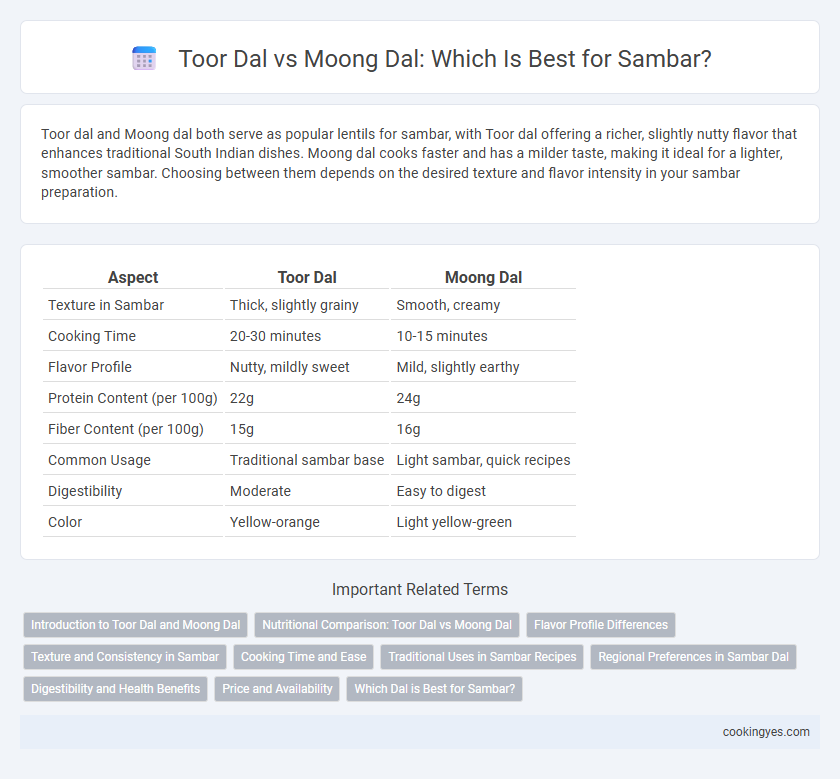Toor dal and Moong dal both serve as popular lentils for sambar, with Toor dal offering a richer, slightly nutty flavor that enhances traditional South Indian dishes. Moong dal cooks faster and has a milder taste, making it ideal for a lighter, smoother sambar. Choosing between them depends on the desired texture and flavor intensity in your sambar preparation.
Table of Comparison
| Aspect | Toor Dal | Moong Dal |
|---|---|---|
| Texture in Sambar | Thick, slightly grainy | Smooth, creamy |
| Cooking Time | 20-30 minutes | 10-15 minutes |
| Flavor Profile | Nutty, mildly sweet | Mild, slightly earthy |
| Protein Content (per 100g) | 22g | 24g |
| Fiber Content (per 100g) | 15g | 16g |
| Common Usage | Traditional sambar base | Light sambar, quick recipes |
| Digestibility | Moderate | Easy to digest |
| Color | Yellow-orange | Light yellow-green |
Introduction to Toor Dal and Moong Dal
Toor dal, also known as pigeon pea, is a staple legume in South Indian cuisine, prized for its nutty flavor and ability to create a rich, hearty sambar. Moong dal, or green gram, is lighter with a milder taste and faster cooking time, often used for a smoother, delicate sambar consistency. Each dal offers unique nutritional benefits and texture, influencing the traditional sambar's taste and preparation method.
Nutritional Comparison: Toor Dal vs Moong Dal
Toor dal and moong dal both serve as excellent protein sources for sambar, but their nutritional profiles differ significantly. Toor dal is rich in dietary fiber and iron, aiding digestive health and maintaining energy levels, while moong dal offers higher protein content and essential vitamins like folate and magnesium, which support muscle function and metabolism. Choosing between the two depends on dietary goals; toor dal enhances fiber intake, whereas moong dal boosts protein and micronutrient consumption.
Flavor Profile Differences
Toor dal offers a robust, nutty flavor and thicker consistency, making it a traditional choice for sambar with a rich, hearty taste. Moong dal provides a milder, slightly sweet flavor and a smoother texture, resulting in a lighter, more delicate sambar. The distinct flavor profiles influence the overall taste, with toor dal delivering depth and moong dal enhancing subtlety in sambar preparation.
Texture and Consistency in Sambar
Toor dal imparts a creamy texture and thicker consistency to sambar, making it rich and hearty, while Moong dal results in a lighter, smoother sambar with a slightly runnier consistency. The coarse grains of Toor dal break down slowly, providing a robust body to the dish, whereas Moong dal cooks faster and yields a more delicate texture. Choosing between Toor dal and Moong dal for sambar ultimately depends on the preferred balance between thickness and smoothness in the final preparation.
Cooking Time and Ease
Toor dal cooks faster than moong dal in sambar, typically requiring about 20-25 minutes compared to moong dal's 30-35 minutes. Moong dal tends to break down more easily, resulting in a smoother, creamier texture, which can simplify the preparation process. Choosing toor dal offers quicker cooking, while moong dal provides ease in achieving the desired consistency without extensive stirring.
Traditional Uses in Sambar Recipes
Toor dal and moong dal both play essential roles in traditional sambar recipes, with toor dal being the preferred choice for its slightly nutty flavor and thicker consistency that perfectly complements the spices and vegetables. Moong dal, while lighter and easier to digest, is often used in regional variations or for quicker sambar preparations where a smooth texture is desired. The traditional use of toor dal in South Indian sambar highlights its robust ability to absorb tamarind and spice flavors, creating a rich and hearty dish central to many meals.
Regional Preferences in Sambar Dal
Toor dal is predominantly preferred in South Indian states like Tamil Nadu and Karnataka for sambar due to its slightly grainy texture and robust flavor, which complements the tamarind base. Moong dal, favored in Kerala and some northern regions, offers a smoother, lighter consistency, making the sambar less thick and easier to digest. Regional culinary traditions influence these preferences, with Toor dal embodying the classic sambar taste while Moong dal provides a subtle variation tailored to local palates.
Digestibility and Health Benefits
Toor dal and Moong dal both serve as popular lentils for sambar, with Moong dal being easier to digest due to its lower fiber content and absence of complex carbohydrates. Moong dal offers higher protein and essential minerals while promoting better gut health, making it suitable for individuals with sensitive digestion. Toor dal, rich in dietary fiber and antioxidants, supports heart health and provides a robust flavor, though it may take longer to digest compared to Moong dal.
Price and Availability
Toor dal, commonly preferred for sambar, is generally priced higher but widely available across Indian markets compared to moong dal. Moong dal is usually more affordable and found in smaller quantities, often used as a substitute when toor dal is out of stock. Pricing fluctuations for both dals depend on seasonal harvests and regional demand, impacting their availability in local stores.
Which Dal is Best for Sambar?
Toor dal is traditionally preferred for sambar due to its distinct nutty flavor and ability to create a thick, rich consistency that enhances the dish's taste and texture. Moong dal, while quicker to cook and lighter on digestion, does not provide the same depth of flavor or creamy texture essential for classic sambar preparation. For authentic sambar, toor dal remains the best choice, delivering the ideal balance of taste, texture, and nutritional benefits.
Toor dal vs Moong dal for sambar Infographic

 cookingyes.com
cookingyes.com